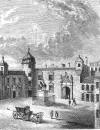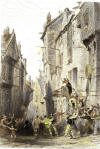|
The Edinburgh Tolbooth aka The Heart of Midlothian
Descriptions from Exiles of the
Covenant by W.D.Carslaw, and The Book of the Old Edinburgh Club vol III.

The Heart of Midlothian
 The exact date when the Old Tolbooth of Edinburgh was erected is shrouded in the mists of time, but reference to it is made as early as 1403; it was substantially rebuilt in the sixteenth century with ongoing ad hoc repairs and finally removed in 18!7.The site The exact date when the Old Tolbooth of Edinburgh was erected is shrouded in the mists of time, but reference to it is made as early as 1403; it was substantially rebuilt in the sixteenth century with ongoing ad hoc repairs and finally removed in 18!7.The site is marked by the figure of a heart in the pavement near the northwest corner is marked by the figure of a heart in the pavement near the northwest corner
of St. Glles’ Church. It served not only as a prison, but also
accommodated Parliament for a while, together with the Court of Session and the Justiciary. It was as a prison though, that it became famous.
As a result of it being a holding prison pending trial or appearances before the Privy Council the records contain a host of references for people passing through to their fate, whether release, continued incarceration, transfer to a remote prison, transportation, banishment and execution. An early Presbyterian visitor was the Rev Nicoll Dalgleish
of the West Kirk in 1584 for praying for banished
compatriots. David Calderwood was sent there in 1617 also
John Hamilton and John Dickson. William Carstares spent
most of 1675-9 in the Tolbooth. Some of the old records of the Edinburgh Tolbooth have been saved for posterity in “The Book of the Old Edinburgh Club” (volumes 4-12), including names of prisoners sent to Dunnottar and transportation.
In 1640 the Parliament House was erected just across from the tolbooth. A consequence was that prisoners who were charged to appear before the Assize, Judiciary Courts, Secret Council, Privy Council etc, were sent to the Edinburgh Tolbooth for holding pending appearance. This meant that the tolbooth was always a very busy place. From 1641 to 1707 the Scots Parliament met in the Great Hall, which has since been sanctified by other associations, a magnificent room 120 feet long, over 40
 feet wide, and 40 feet high. At the south end of this Hall, under the great window, stood the Throne, between which and the Clerk’s Table a vacant space was marked by a bar, at which persons cited before the House appeared. On either side of the Throne, Benches were reserved for the Nobility and the Bishops; at some distance down the Chamber the Lords of Session sat at a table allotted to them, while beyond them , and at the end of the Hall, remote from the Throne, the representatives of the Shires and Burghs were accommodated with “forms”. The Lords and Commons used to sit `cheek by jowel`, which according to the ultra patriotic Andrew Fairservice of Saltoun it was an amicable arrangement since “they didna` need to hae the same blethers twice ower again.” feet wide, and 40 feet high. At the south end of this Hall, under the great window, stood the Throne, between which and the Clerk’s Table a vacant space was marked by a bar, at which persons cited before the House appeared. On either side of the Throne, Benches were reserved for the Nobility and the Bishops; at some distance down the Chamber the Lords of Session sat at a table allotted to them, while beyond them , and at the end of the Hall, remote from the Throne, the representatives of the Shires and Burghs were accommodated with “forms”. The Lords and Commons used to sit `cheek by jowel`, which according to the ultra patriotic Andrew Fairservice of Saltoun it was an amicable arrangement since “they didna` need to hae the same blethers twice ower again.”
The doorway to the Great Hall was flanked by two statues – of Justice and Mercy about which an amusing anecdote is on record. This concerned a noted Jacobite Robertson of Kincraigie who was invited to look in the Law Courts by the Hon. Harry Erskine, Dean of Faculty. Robertson declined with the witticism
” But I`ll tell ye what Harry; tak in Justice wi` ye, for she has stood lang at the door, and it wad be a treat for her to see inside like ither strangers.”
When the tolbooth was removed, with the mass of
buildings of which it formed a part, the stones which composed the gateway,
together with the door and its ponderous fastenings, were conveyed to
Abbotsford, and employed by Sir Walter Scott in decorating the entrance to
the court.

A prisoner being taken down to the Grassmarket for execution.
Extracts from the records of the Edinburgh Tolbooth.
Transportations.
Escapes from the Tolbooth
|